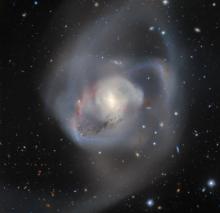Listen to today's episode of StarDate on the web the same day it airs in high-quality streaming audio without any extra ads or announcements. Choose a $8 one-month pass, or listen every day for a year for just $30.
You are here
Leo’s Triplets
Most of the “star pictures” in the night sky look nothing like their namesakes. But one beautiful exception lunges across the southwestern sky on May evenings: Leo, the lion. It’s high in the sky at nightfall.
Leo consists of two patterns of stars that the brain puts together to make a lion. A backward question mark represents the head and mane. And a triangle of stars to the lower left forms the lion’s hindquarters and tail.
Leo is best known for its bright stars – particularly Regulus, its brilliant heart. But the constellation also contains quite a few bright galaxies. Leading the list are three galaxies that together form the Leo Triplet: M65, M66, and NGC 3628.
NGC 3628 is the most interesting of the three. Like our own Milky Way, it’s a spiral — a pinwheel that spans at least a hundred thousand light-years. We see it edge-on, so it looks like a streak of light with lanes of dark dust running down the middle.
Gravitational encounters with the other galaxies have really pumped up NGC 3628.
They’ve triggered the birth of perhaps millions of new stars near the galaxy’s center. And they’ve pulled out a tail of gas that spans a quarter of a million light-years — enough gas to make half a billion stars as massive as the Sun. In fact, the tail has already given birth to millions of stars in several large clumps.
The Leo Triplet is just one of the wonders in one of the night sky’s most easily recognizable constellations: the lion.
Script by Damond Benningfield






